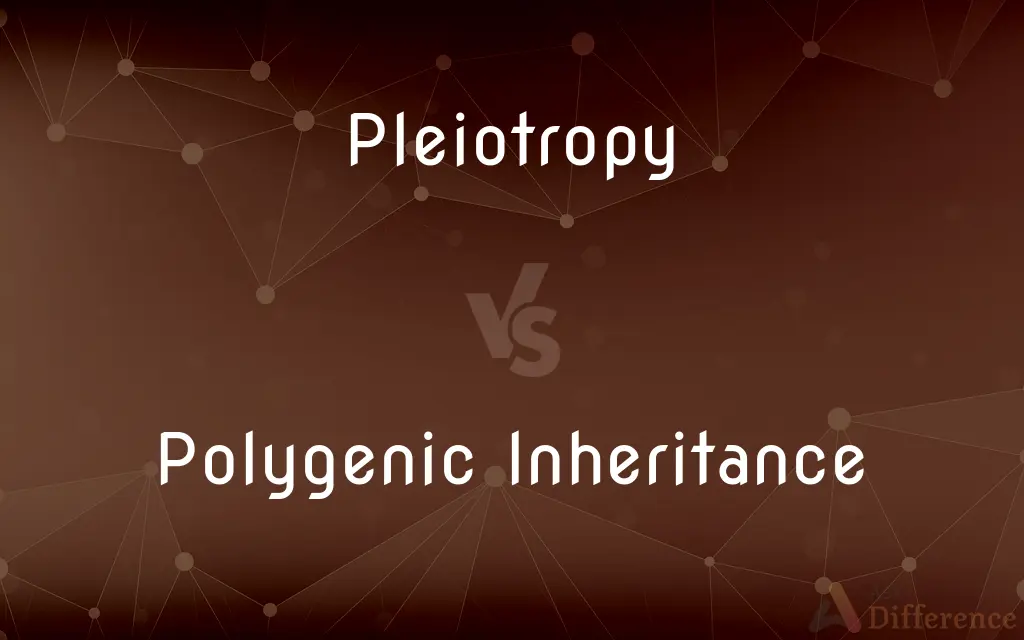Pleiotropy vs. Polygenic Inheritance — What's the Difference?
By Tayyaba Rehman — Published on January 9, 2024
Pleiotropy occurs when one gene influences multiple traits, while polygenic inheritance involves multiple genes affecting one trait.

Difference Between Pleiotropy and Polygenic Inheritance
Table of Contents
ADVERTISEMENT
Key Differences
Pleiotropy refers to a scenario where a single gene affects multiple, seemingly unrelated traits. Polygenic inheritance, on the other hand, describes a situation where multiple genes contribute to the expression of a single trait.
In pleiotropy, the impact of one gene can be widespread, affecting various aspects of an organism’s phenotype. Contrastingly, in polygenic inheritance, the collective influence of several genes determines the outcome of one characteristic, often resulting in a continuous variation of that trait.
The concept of pleiotropy highlights the interconnectedness of biological systems, where one genetic change can have ripple effects. Conversely, polygenic inheritance illustrates the complexity and diversity of genetic contributions to specific traits, such as height or skin color.
Both pleiotropy and polygenic inheritance demonstrate the intricate nature of genetics, but they operate on different mechanisms. Pleiotropy showcases the broad influence of a single gene, while polygenic inheritance underscores the collaborative effect of multiple genes.
Understanding pleiotropy and polygenic inheritance is crucial in fields like medicine and evolutionary biology. Pleiotropy can explain certain genetic disorders, whereas polygenic inheritance is key to understanding variations within populations.
ADVERTISEMENT
Comparison Chart
Definition
One gene influences multiple traits
Multiple genes influence one trait
Impact on Traits
Widespread effects from a single gene
Collective effect of genes on a single characteristic
Genetic Complexity
Single gene with broad influence
Multiple genes with combined influence
Example Traits Affected
Marfan syndrome affecting eyes, heart, and limbs
Height, skin color, and intelligence
Relevance in Biology
Explains genetic disorders, evolutionary changes
Understands variations within populations
Compare with Definitions
Pleiotropy
One gene influences multiple phenotypic traits.
The gene causing Marfan syndrome leads to various symptoms like long limbs and heart issues.
Polygenic Inheritance
Combined genetic influence on a trait.
Skin color variations result from the interplay of multiple genes.
Pleiotropy
Genetic connectivity across different traits.
A gene mutation causing white fur in animals may also lead to hearing problems, demonstrating pleiotropy.
Polygenic Inheritance
Many genes, one characteristic.
Eye color is determined by the interaction of multiple genes, not just one.
Pleiotropy
A single genetic change with broad effects.
Sickle cell anemia, caused by a single gene mutation, affects blood cells, pain levels, and immunity.
Polygenic Inheritance
Multiple genes determine one trait.
Human height is influenced by several genes, demonstrating polygenic inheritance.
Pleiotropy
One gene, diverse outcomes.
A single gene mutation can cause cystic fibrosis, affecting lungs, pancreas, and sweat glands.
Polygenic Inheritance
Collective gene effect on phenotype.
Intelligence is shaped by numerous genes, each contributing a small effect.
Pleiotropy
A gene’s multiple roles in an organism.
The gene responsible for coat color in mice also affects their susceptibility to infections.
Polygenic Inheritance
Genes collaborate for a single outcome.
The risk of developing type 2 diabetes is influenced by the combined effect of many genes.
Pleiotropy
The production of diverse effects, especially the production by a single gene of several distinct and seemingly unrelated phenotypic effects.
Pleiotropy
(genetics) The influence of a single gene on multiple phenotypic traits; pleiotropism.
Pleiotropy
(pharmacology) The existence of drug effects other than the one for which the drug was designed; usually implies additional beneficial effects.
Common Curiosities
Is height an example of polygenic inheritance?
Yes, height is influenced by multiple genes.
What is an example of pleiotropy?
Marfan syndrome is an example, where one gene affects multiple body systems.
Can pleiotropy affect unrelated traits?
Yes, it can influence seemingly unrelated physical and physiological traits.
How does pleiotropy relate to evolutionary biology?
It shows how one genetic change can have multiple effects, impacting evolution.
Are all genetic disorders due to pleiotropy?
Not all; some disorders are caused by mutations in a single gene affecting one specific function.
Can pleiotropy complicate disease treatment?
Yes, because treating one symptom may affect other traits controlled by the same gene.
Are most traits in humans pleiotropic or polygenic?
Many traits, like height and skin color, are polygenic.
Is polygenic inheritance common in animals?
Yes, many traits in animals are also polygenic.
Can polygenic inheritance lead to a range of trait expressions?
Yes, it often results in a continuous spectrum of trait variations.
How does pleiotropy impact genetic disorders?
It can explain why some genetic disorders have diverse symptoms.
Can environment influence polygenic traits?
Yes, environmental factors can interact with genes to influence these traits.
How do scientists study polygenic traits?
Through genetic mapping and statistical models to assess multiple genes' contributions.
Does pleiotropy mean a gene is more important?
Not necessarily; it means the gene has broader influences.
Is eye color polygenic?
Yes, multiple genes contribute to eye color variations.
Can pleiotropy be beneficial?
Yes, in some cases, it can lead to advantageous traits in organisms.
Share Your Discovery

Previous Comparison
Revolutionary War vs. Civil War
Next Comparison
Zsh vs. BashAuthor Spotlight
Written by
Tayyaba RehmanTayyaba Rehman is a distinguished writer, currently serving as a primary contributor to askdifference.com. As a researcher in semantics and etymology, Tayyaba's passion for the complexity of languages and their distinctions has found a perfect home on the platform. Tayyaba delves into the intricacies of language, distinguishing between commonly confused words and phrases, thereby providing clarity for readers worldwide.
















































